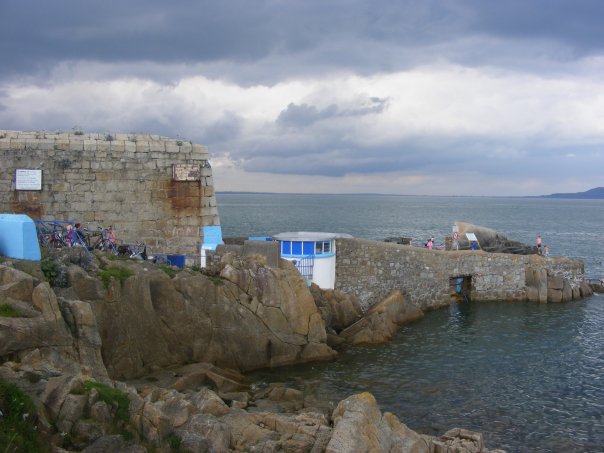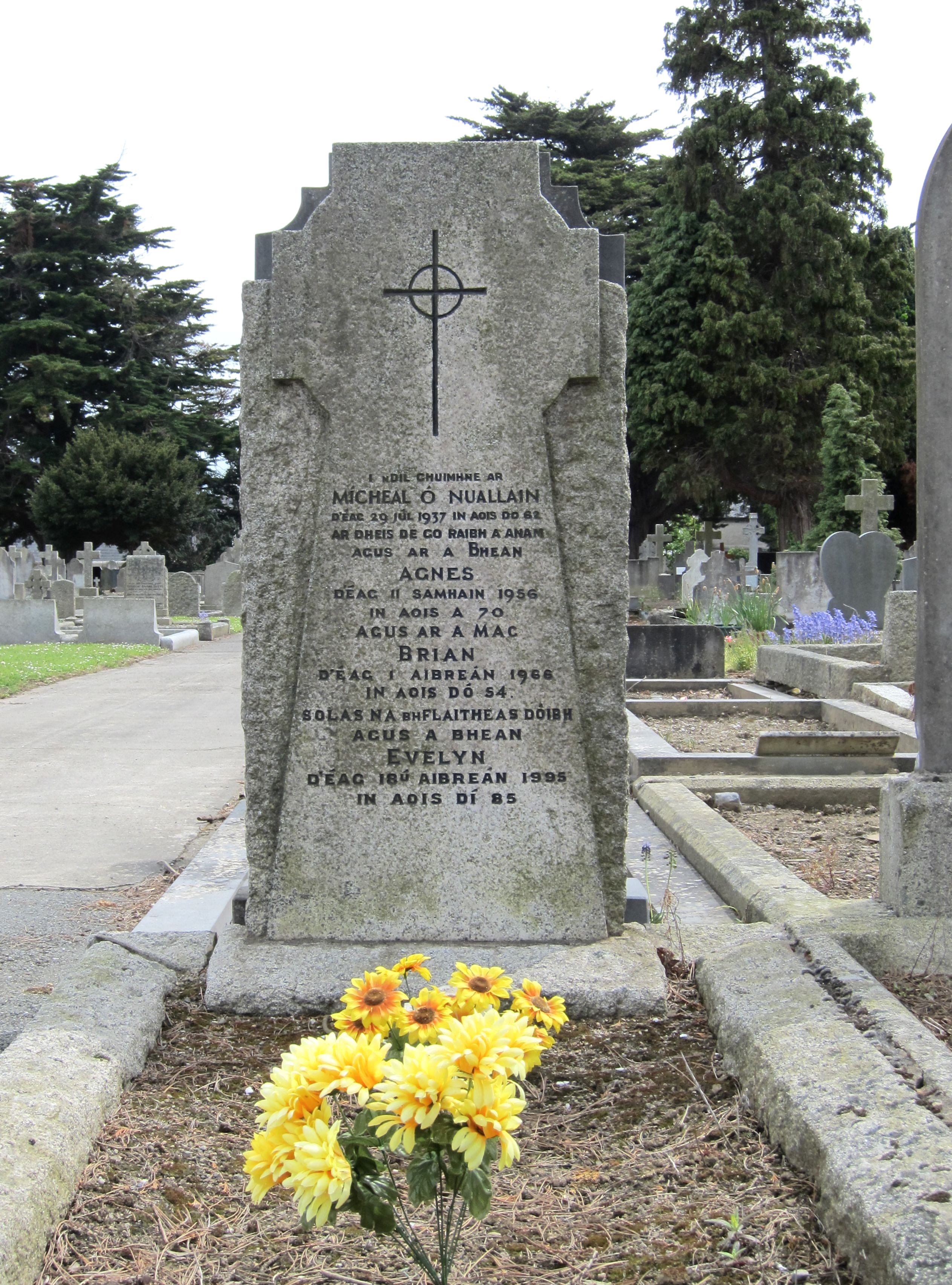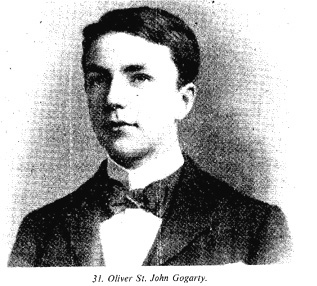|
Forty Foot
The Forty Foot () is a promontory on the southern tip of Dublin Bay at Sandycove, County Dublin, Ireland, from which people have been swimming in the Irish Sea all year round for some 250 years. * * Name The name "Forty Foot" is somewhat obscure. On an 1833 map, the Marine Road (located to the west) was named the Forty Foot Road, possibly because it was wide; the name may have been transferred to the swimming place, which was called the Forty-Foot Hole in the 19th century. Other accounts claim the name was given by fishermen because it was forty feet ( fathoms) deep, but the water in the area is no deeper than . Others have attempted to link it to the 40th (the 2nd Somersetshire) Regiment of Foot, who supposedly bathed there, but they were stationed at Richmond Barracks in Inchicore. Use At first, it was exclusively a male bathing place, and ''Sandycove Bathers Association'', a men's swimming club was established. Owing to its relative isolation and gender-restrictions ... [...More Info...] [...Related Items...] OR: [Wikipedia] [Google] [Baidu] |
Dublin
Dublin (; , or ) is the capital and largest city of Ireland. On a bay at the mouth of the River Liffey, it is in the province of Leinster, bordered on the south by the Dublin Mountains, a part of the Wicklow Mountains range. At the 2016 census it had a population of 1,173,179, while the preliminary results of the 2022 census recorded that County Dublin as a whole had a population of 1,450,701, and that the population of the Greater Dublin Area was over 2 million, or roughly 40% of the Republic of Ireland's total population. A settlement was established in the area by the Gaels during or before the 7th century, followed by the Vikings. As the Kingdom of Dublin grew, it became Ireland's principal settlement by the 12th century Anglo-Norman invasion of Ireland. The city expanded rapidly from the 17th century and was briefly the second largest in the British Empire and sixth largest in Western Europe after the Acts of Union in 1800. Following independence in 1922, Dubli ... [...More Info...] [...Related Items...] OR: [Wikipedia] [Google] [Baidu] |
Women's Liberation Movement
The women's liberation movement (WLM) was a political alignment of women and feminist intellectualism that emerged in the late 1960s and continued into the 1980s primarily in the industrialized nations of the Western world, which effected great change (political, intellectual, cultural) throughout the world. The WLM branch of radical feminism, based in contemporary philosophy, comprised women of racially- and culturally-diverse backgrounds who proposed that economic, psychological, and social freedom were necessary for women to progress from being second-class citizens in their societies. Towards achieving the equality of women, the WLM questioned the cultural and legal validity of patriarchy and the practical validity of the social and sexual hierarchies used to control and limit the legal and physical independence of women in society. Women's liberationists proposed that sexism—legalized formal and informal sex-based discrimination predicated on the existence of the social ... [...More Info...] [...Related Items...] OR: [Wikipedia] [Google] [Baidu] |
Flann O'Brien
Brian O'Nolan ( ga, Brian Ó Nualláin; 5 October 1911 – 1 April 1966), better known by his pen name Flann O'Brien, was an Irish civil service official, novelist, playwright and satirist, who is now considered a major figure in twentieth century Irish literature. Born in Strabane, County Tyrone, he is regarded as a key figure in modernist and postmodern literature. His English language novels, such as ''At Swim-Two-Birds'' and ''The Third Policeman'', were written under the O’Brien pen name. His many satirical columns in ''The Irish Times'' and an Irish language novel ''An Béal Bocht'' were written under the name Myles na gCopaleen. O'Brien's novels have attracted a wide following for their unconventional humour and modernist metafiction. As a novelist, O'Brien was influenced by James Joyce. He was nonetheless sceptical of the "cult" of Joyce, saying "I declare to God if I hear that name Joyce one more time I will surely froth at the gob." Biography Family and ea ... [...More Info...] [...Related Items...] OR: [Wikipedia] [Google] [Baidu] |
At Swim-Two-Birds
''At Swim-Two-Birds'' is a 1939 novel by Irish writer Brian O'Nolan, writing under the pseudonym Flann O'Brien. It is widely considered to be O'Brien's masterpiece, and one of the most sophisticated examples of metafiction. The novel's title derives from ''Snám dá Én'' (Middle Irish: "The narrow water of the two birds"; Modern Irish: ''Snámh Dá Éan''), an ancient ford on the River Shannon, between Clonmacnoise and Shannonbridge, reportedly visited by the legendary King Sweeney, a character in the novel. The novel was included in ''Time'' magazine's list of the 100 best English-language novels from 1923 to 2005. It was also included in a list, published by ''The Guardian'', of the 100 best English-language novels of all time. Plot summary ''At Swim-Two-Birds'' presents itself as a first-person story by an unnamed Irish student of literature. The student believes that "one beginning and one ending for a book was a thing I did not agree with", and he accordingly set ... [...More Info...] [...Related Items...] OR: [Wikipedia] [Google] [Baidu] |
Buck Mulligan
Malachi Roland St. John "Buck" Mulligan is a fictional character in James Joyce's 1922 novel '' Ulysses''. He appears most prominently in episode 1 ''(Telemachus)'', and is the subject of the novel's famous first sentence: "Stately, plump Buck Mulligan came from the stairhead, bearing a bowl of lather on which a mirror and a razor lay crossed." Characteristics Physical appearance Buck Mulligan is described as having a "face... equine in its length", a "sullen oval jowl",''Ulysses'', p. 3 a "strong wellknit trunk",''Ulysses'', p. 6 "light untonsured hair, grained and hued like pale oak", "even white teeth", and "smokeblue mobile eyes." He begins the morning in a yellow dressing-gown; later he dons a distinctive primrose waistcoat and Panama hat. His facial expressions often shift rapidly, and he is prone to sudden, energetic movements. Personality Mulligan is a medical student with a cynical view of the human condition, which he describes as "a mockery and beastly". Paradoxica ... [...More Info...] [...Related Items...] OR: [Wikipedia] [Google] [Baidu] |
Stephen Dedalus
Stephen Dedalus is James Joyce's literary alter ego, appearing as the protagonist and antihero of his first, semi-autobiographic novel of artistic existence ''A Portrait of the Artist as a Young Man'' (1916) and an important character in Joyce's 1922 novel '' Ulysses''. In ''Stephen Hero'', an early version of what became ''Portrait'', Stephen's surname is spelled "Daedalus" in more precise allusion to Daedalus, the architect in Greek myth who was contracted by King Minos to build the Labyrinth in which he would imprison his wife's son the Minotaur.Ovid, in his ''Metamorphoses'', suggests that Daedalus constructed the Labyrinth so cunningly that he himself could barely escape it after he built it. Buck Mulligan makes reference to the mythic namesake in ''Ulysses'', telling Stephen, "Your absurd name, an ancient Greek!" In revising the mammoth ''Stephen Hero'' into the considerably more compact ''Portrait of the Artist as a Young Man'', Joyce shortened the name to "Dedalus". Fic ... [...More Info...] [...Related Items...] OR: [Wikipedia] [Google] [Baidu] |
Ulysses (novel)
''Ulysses'' is a modernist novel by Irish writer James Joyce. Parts of it were first serialized in the American journal '' The Little Review'' from March 1918 to December 1920, and the entire work was published in Paris by Sylvia Beach on 2 February 1922, Joyce's 40th birthday. It is considered one of the most important works of modernist literature and has been called "a demonstration and summation of the entire movement." According to Declan Kiberd, "Before Joyce, no writer of fiction had so foregrounded the process of thinking". ''Ulysses'' chronicles the appointments and encounters of the itinerant Leopold Bloom in Dublin in the course of an ordinary day, 16 June 1904. Ulysses is the Latinised name of Odysseus, the hero of Homer's epic poem the ''Odyssey'', and the novel establishes a series of parallels between the poem and the novel, with structural correspondences between the characters and experiences of Bloom and Odysseus, Molly Bloom and Penelope, and Stephen Ded ... [...More Info...] [...Related Items...] OR: [Wikipedia] [Google] [Baidu] |
James Joyce Tower And Museum
The James Joyce Tower and Museum is a Martello tower in Sandycove, Dublin, where James Joyce spent six nights in 1904. The opening scenes of his 1922 novel '' Ulysses'' take place here, and the tower is a place of pilgrimage for Joyce enthusiasts, especially on Bloomsday. Admission is free. History The tower was leased from the War Office by Joyce's university friend Oliver St. John Gogarty, with the purpose of " Hellenising" Ireland. Joyce stayed there for six days, from 9 to 14 September in 1904. Gogarty later attributed Joyce's abrupt departure to a midnight incident with a loaded revolver. The opening scenes of '' Ulysses'' are set the morning after this incident. Gogarty is immortalised as "Stately, plump Buck Mulligan" (the opening words of the novel). The tower now contains a museum dedicated to Joyce and displays some of his possessions and other ephemera associated with ''Ulysses'' (e.g., "Plumtree's Potted Meat" pot). The living space is set up to resemble its 1904 a ... [...More Info...] [...Related Items...] OR: [Wikipedia] [Google] [Baidu] |
Martello Tower
Martello towers, sometimes known simply as Martellos, are small defensive forts that were built across the British Empire during the 19th century, from the time of the French Revolutionary Wars onwards. Most were coastal forts. They stand up to high (with two floors) and typically had a garrison of one officer and 15–25 men. Their round structure and thick walls of solid masonry made them resistant to cannon fire, while their height made them an ideal platform for a single heavy artillery piece, mounted on the flat roof and able to traverse, and hence fire, over a complete 360° circle. A few towers had moats or other batteries and works attached for extra defence. The Martello towers were used during the first half of the 19th century, but became obsolete with the introduction of powerful rifled artillery. Many have survived to the present day, often preserved as historic monuments. Origins Martello towers were inspired by a round fortress, part of a larger Genoese ... [...More Info...] [...Related Items...] OR: [Wikipedia] [Google] [Baidu] |
Oliver St
Oliver may refer to: Arts, entertainment and literature Books * ''Oliver the Western Engine'', volume 24 in ''The Railway Series'' by Rev. W. Awdry * '' Oliver Twist'', a novel by Charles Dickens Fictional characters * Ariadne Oliver, in the novels of Agatha Christie * Oliver (Disney character) * Oliver Fish, a gay police officer on the American soap opera ''One Life to Live'' * Oliver Hampton, in the American television series ''How to Get Away with Murder'' * Oliver Jones (''The Bold and the Beautiful''), on the American soap opera ''The Bold and the Beautiful'' * Oliver Lightload, in the movie ''Cars'' * Oliver Oken, from ''Hannah Montana'' * Oliver (paladin), a paladin featured in the Matter of France * Oliver Queen, DC Comic book hero also known as the Green Arrow * Oliver (Thomas and Friends character), a locomotive in the Thomas and Friends franchise * Oliver Trask, a controversial minor character from the first season of ''The O.C.'' * Oliver Twist (char ... [...More Info...] [...Related Items...] OR: [Wikipedia] [Google] [Baidu] |
James Joyce
James Augustine Aloysius Joyce (2 February 1882 – 13 January 1941) was an Irish novelist, poet, and literary critic. He contributed to the modernist avant-garde movement and is regarded as one of the most influential and important writers of the 20th century. Joyce's novel '' Ulysses'' (1922) is a landmark in which the episodes of Homer's ''Odyssey'' are paralleled in a variety of literary styles, particularly stream of consciousness. Other well-known works are the short-story collection '' Dubliners'' (1914), and the novels '' A Portrait of the Artist as a Young Man'' (1916) and '' Finnegans Wake'' (1939). His other writings include three books of poetry, a play, letters, and occasional journalism. Joyce was born in Dublin into a middle-class family. He attended the Jesuit Clongowes Wood College in County Kildare, then, briefly, the Christian Brothers-run O'Connell School. Despite the chaotic family life imposed by his father's unpredictable finances, he excelled at the Jes ... [...More Info...] [...Related Items...] OR: [Wikipedia] [Google] [Baidu] |
Irish Examiner
The ''Irish Examiner'', formerly ''The Cork Examiner'' and then ''The Examiner'', is an Irish national daily newspaper which primarily circulates in the Munster region surrounding its base in Cork, though it is available throughout the country. History 19th and early 20th centuries The paper was founded by John Francis Maguire under the title ''The Cork Examiner'' in 1841 in support of the Catholic Emancipation and tenant rights work of Daniel O'Connell. Historical copies of ''The Cork Examiner'', dating back to 1841, are available to search and view in digitised form at the Irish Newspaper Archives website and British Newspaper Archive. During the Irish War of Independence and Irish Civil War, the ''Cork Examiner'' (along with other nationalist newspapers) was subject to censorship and suppression. At the time of the Spanish Civil War, the ''Cork Examiner'' reportedly took a strongly pro- Franco tone in its coverage of the conflict. As of the early to mid-20th century, th ... [...More Info...] [...Related Items...] OR: [Wikipedia] [Google] [Baidu] |


.jpg)





.jpg)